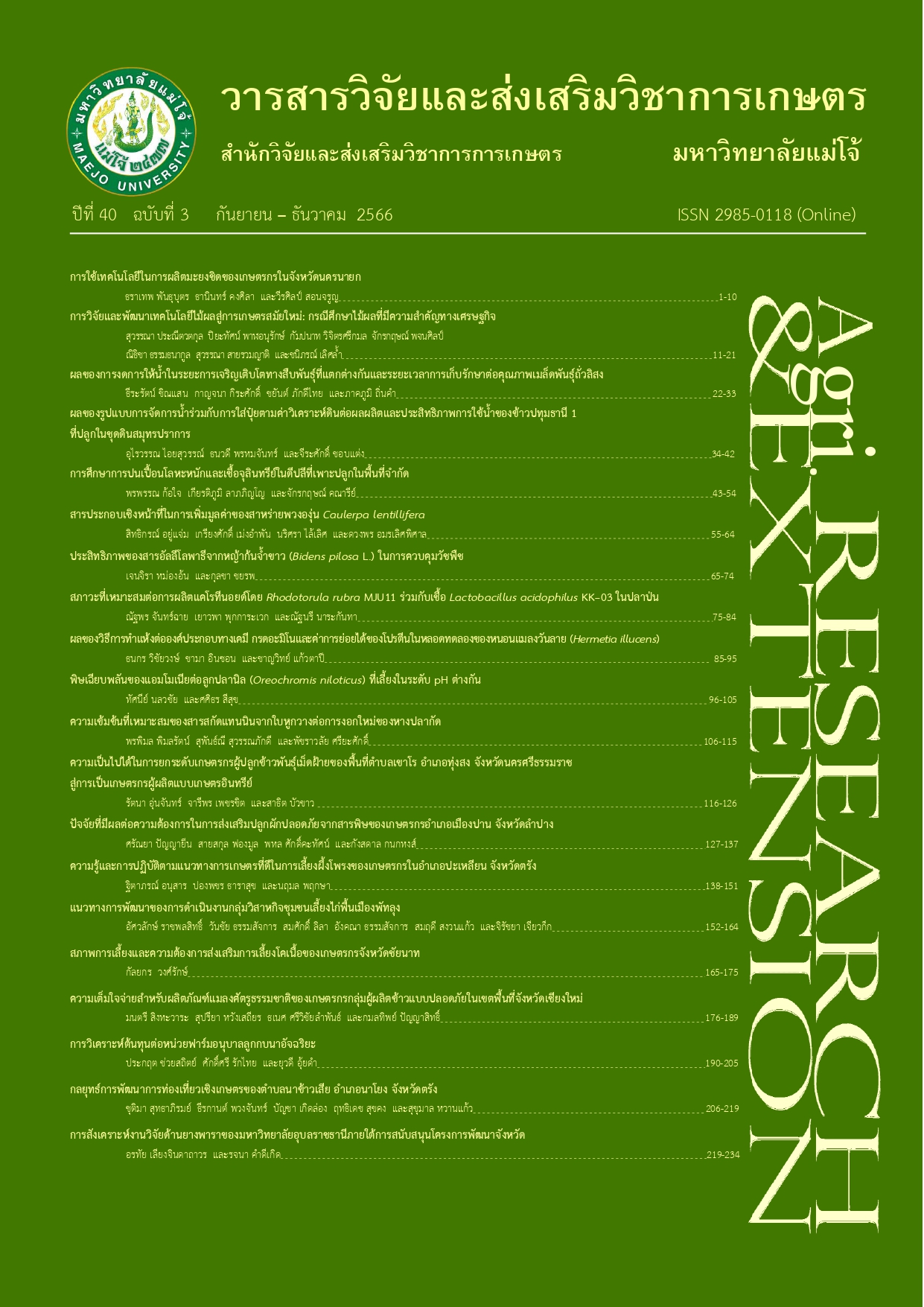ผลของการงดการให้น้ำในระยะการเจริญเติบโตทางสืบพันธุ์ที่แตกต่างกัน และระยะเวลาการเก็บรักษาต่อคุณภาพเมล็ดพันธุ์ถั่วลิสง
คำสำคัญ:
เปอร์เซ็นต์ความงอก, เวลาเฉลี่ยในการงอก, ดัชนีความงอก, ค่าการนำไฟฟ้าบทคัดย่อ
ระยะการเจริญเติบโตทางสืบพันธุ์ของถั่วลิสง มีความต้องการน้ำสูงเพื่อการเจริญเติบโตและพัฒนาการของเมล็ด ขณะเดียวกันเมล็ดถั่วลิสงมีไขมันเป็นองค์ประกอบสูงซึ่งส่งผลต่ออายุการเก็บรักษา ดังนั้น การศึกษานี้จึงมีวัตถุประสงค์เพื่อศึกษาคุณภาพเมล็ดพันธุ์ถั่วลิสงที่ต้นแม่ได้รับการงดการให้น้ำในช่วงระยะ การเจริญเติบโตทางสืบพันธุ์และระยะเวลาในการเก็บรักษาที่แตกต่างกัน ดำเนินการปลูกถั่วลิสงในเดือนธันวาคม พ.ศ. 2563 ณ แปลงทดลองศูนย์วิจัยพืชไร่ขอนแก่น อำเภอเมือง จังหวัดขอนแก่น โดยงดการให้น้ำถั่วลิสงพันธุ์ขอนแก่น 9 และไทนาน 9 ในช่วงระยะการเจริญเติบโตทางสืบพันธุ์ที่แตกต่างกัน 5 ระยะ ได้แก่ (1) ให้น้ำตลอดฤดูปลูก (2) งดการให้น้ำช่วงออกดอกถึงแทงเข็ม (3) งดการให้น้ำช่วงแทงเข็มถึงติดฝัก (4) งดการให้น้ำช่วงติดฝักถึงพัฒนาเมล็ด และ (5) งดการให้น้ำช่วงพัฒนาเมล็ดถึงเมล็ดเต็มฝัก จากนั้นเก็บรักษาถั่วลิสงในรูปแบบฝักเพื่อทดสอบคุณภาพเมล็ดพันธุ์ที่อายุเก็บรักษานาน 0, 2 และ 4 เดือน จากการศึกษาพบว่า การงดการให้น้ำถั่วลิสงในช่วงพัฒนาเมล็ดถึงเมล็ดเต็มฝักมีผลให้ค่าการนำไฟฟ้าของเมล็ดพันธุ์เพิ่มขึ้น เท่ากับ 26.81 µS/cm/g ขณะที่ ถั่วลิสงพันธุ์ไทนาน 9 มีคุณภาพเมล็ดพันธุ์สูงกว่าพันธุ์ขอนแก่น 9 โดยถั่วลิสงทั้งสองพันธุ์สามารถเก็บรักษา ในสภาพห้องทั่วไปได้นาน 4 เดือน ซึ่งไม่ส่งผลต่อคุณภาพเมล็ดพันธุ์ และช่วงอายุการเก็บรักษาดังกล่าวมีผลให้ ถั่วลิสงมีคุณภาพเมล็ดพันธุ์สูงกว่าการเก็บรักษานาน 2 เดือน หรือก่อนการเก็บรักษา
เอกสารอ้างอิง
Association of Official Seed Analysis. 1983. Seed Vigor Testing Handbook. Contribution No.32. Lincon: Association of Official Seed Analysis. 89 p.
Boontang, S., T. Girdthai, S. Jogloy, C. Akkasaeng, N. Vorasoot, A. Patanothai and N. Tantisuwichwong. 2010. Responses of released cultivars of peanut to terminal drought for traits related to drought tolerance. Asian Journal of Plant Sciences 9(7): 423-431.
Chanprasert, W. 2010. Seed Physiology. Special ed. Bangkok: Extension and Training Office, Kasetsart University. 167 p. [in Thai]
Copeland, L.O. and M.B. McDonald. 1999. Principles of Seed Science and Technology. 3thed. Minnepolis: Burgress Publishing Co. 409 p.
Department of Agriculture. 2020. Peanut Tainan 9. [Online]. Available http://202.139.197.174/RecFront/PlantDetailPdf/18 (October 8, 2021). [in Thai]
Department of Agriculture. 2021. Peanut Khon Kaen 9. [Online]. Available http://202.139.197.174/RecFront/PlantDetailPdf/353 (October 8, 2021). [in Thai]
Dongsansuk, A. 2017. Physiological Responses of Plants to Environments. 1sted. Khon Kaen: Faculty of Agriculture, Khon Kaen University. 131 p. [in Thai]
Ellis, R.H. and E.H. Roberts. 1980. The influence of temperature and moisture on seed viability period in barley (Hordeum distichum L.). Ann. Bot. 45: 31-37.
El-Saidy, A.E.A. and K.M. Abd El-Hai. 2011. Alleviation of peanut seed deterioration during storage using biotic and abiotic agents. Res. J. Seed Sci. 4(2): 64-81.
Field and Renewable Energy Crops Research Institute. 2020. Peanut Production Technology. Bangkok: Department of Agriculture, Ministry of Agriculture and Cooperatives. 10 p. [in Thai]
Ghassemi-Golezani, K., R. Lotfi and M. Norouzi. 2012. Seed quality of soybean cultivars affected by pod position and waterstress at reproductive stages. The International Journal of Plant, Animal and Environmental Sciences 2(2): 119-125.
Hassan, F.U. and M. Ahmed. 2012. Oil and fatty acid composition of peanut cultivars grown in pakistan. Pak. J. Bot. 44(2): 627-630.
Higg, J. 2003. The beneficial role of peanuts in the diet-part 2. Nutr. Food Sci. 33: 56-64.
Hu, B., J. Cao, K. Ge and L. Ling. 2010. The site of water stress governs the pattern of ABA synthesis and transport in peanut. Scientific Reports 6: 1-11.
International Seed Testing Association. 2010. International Rules for Seed Testing: Edition 2010. Bassersdorf: ISTA. 53 p.
Kasemsap, P. 2006. Biology 2. 1sted. Bangkok: The Project of Science and Mathematics Book, The Promotion of Academic Olympiad and Development of Science Education Foundation. 404 p. [in Thai]
Khon Kaen Field Crops Research Center. n.d.a. Peanut Khon Kaen 6: Large-seeded in Thai Peanut Cultivar. Khon Kaen: Field and Renewable Energy Crops Research Institute (FCRI), Department of Agriculture. 5 p. [in Thai]
Khon Kaen Field Crops Research Center. n.d.b. Peanut Khon Kaen 9: New Shelling Cultivar. Khon Kaen: Field and Renewable Energy Crops Research Institute (FCRI), Department of Agriculture. 5 p. [in Thai]
Probert, R.J. and F.R. Hay. 2000. Keeping Seeds Alive. pp 375-410. In Bewley S.D. (ed.) Seed Technology and Its Biological Basis. Sheffield: Sheffield Academic Press.
Promchote, P. 2000. Seed Deterioration of Peanut at Different Maturity Levels. Master Thesis. Kasetsart University. 245 p. [in Thai]
Promchote, P., J. Duangpatra and W. Chanprasert. 2008. Seed composition and physiological changes in Thai peanut cv. Kaset 1 and Tainan 9 during maturation. Kasetsart J. (Nat. Sci.) 42: 407-416.
Righetti, K., J.L. Vu, S. Pelletier, B.L. Vu, E. Glaab, D. Lalanne, A. Pasha, R.V. Patel, N.J. Provart, J. Verdier, O. Leprince and J. Buitinka. 2015. Inference of longevity-related genes from a robust coexpression network of seed maturation identifies regulators linking seed storability to biotic defense-related pathways. Plant Cell 27: 2692-2708.
Schnyder, H. and U. Baum. 1992. Growth of the grain of wheat (Triticum aestivum L.) the relationship between water content and dry matter accumulation. Eur. J. Agron. 1: 51-57.
Sevanto, S. 2014. Phloem transport and drought. J. Exp. Bot. 65: 1751-1759.
Songsri, P., S. Jogloy, T. Kesmala, N. Vorasoot, C. Akkasaeng, A. Patanothai and C.C. Holbrook. 2008. Response of reproductive characters of drought resistant peanut genotypes to drought. Asian J. Plant Sci. 7: 427-439.
Sukprakarn, S. 2002. Horticultural Seed Testing Laboratory. 5thed. Bangkok: Department of Horticulture, Faculty of Agriculture, Kasetsart University. 211 p. [in Thai]
Teekachunhatean, T. 1997. Development of seed dormancy in peanuts (Arachis hypogaea L.) variety Khon Kean 60-1, Khon Kean 60-3 and Tainan 9. [Online]. Available http://sutir.sut.ac.th:8080/jspui/bitstream/123456789/860/1/bib269.pdf (November 13, 2021). [in Thai]
Teekachunhatean, T. 2006. Development of seed dormancy in peanuts (Arachis hypogaea L.) variety Khon Kaen 60-1, Khon Kaen 60-3 and Tainan 9. [Online]. Available http://ird.sut.ac.th/ird_engine/view_detail.php?mode=research&id=3 (November 13, 2021).
Thongket, T. 2009. Seed quality mornitoring. [Online]. Available https://www.thasta.com/pdf/article/การดูแลรักษาคุณภาพเมล็ดพันธุ์.pdf (November 17, 2020). [in Thai]
Xu, P., G. Tang, W. Cui, G. Chen, C.L. Ma, J. Zhu, P. Li, L. Shan, Z. Liu and S. Wan. 2020. Transcriptional differences in peanut (Arachis hypogaea L.) seeds at the freshly harvested, after-ripening and newly germinated seed stages: insights into the regulatory networks of seed dormancy release and germination. PLoS ONE. 15(1): e0219413.
ดาวน์โหลด
เผยแพร่แล้ว
รูปแบบการอ้างอิง
ฉบับ
ประเภทบทความ
สัญญาอนุญาต
ลิขสิทธิ์ (c) 2023 วารสารวิจัยและส่งเสริมวิชาการเกษตร

อนุญาตภายใต้เงื่อนไข Creative Commons Attribution-NonCommercial-NoDerivatives 4.0 International License.
บทความนี้ได้รับการเผยแพร่ภายใต้สัญญาอนุญาต Creative Commons Attribution-NonCommercial-NoDerivatives 4.0 International (CC BY-NC-ND 4.0) ซึ่งอนุญาตให้ผู้อื่นสามารถแชร์บทความได้โดยให้เครดิตผู้เขียนและห้ามนำไปใช้เพื่อการค้าหรือดัดแปลง หากต้องการใช้งานซ้ำในลักษณะอื่น ๆ หรือการเผยแพร่ซ้ำ จำเป็นต้องได้รับอนุญาตจากวารสาร





